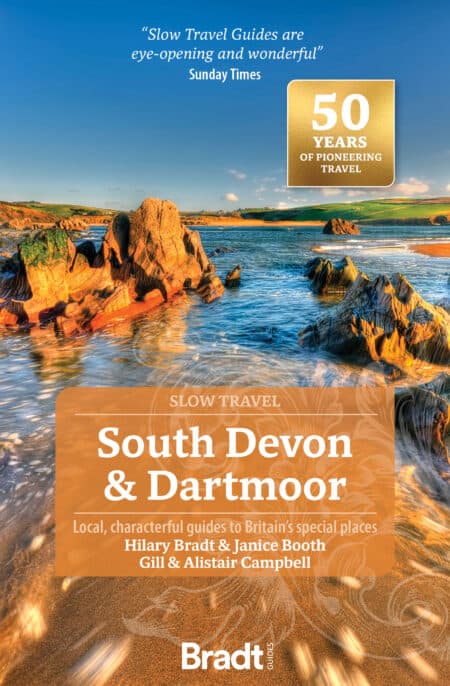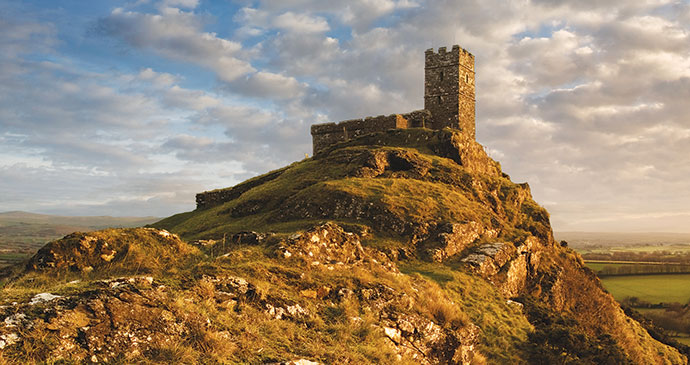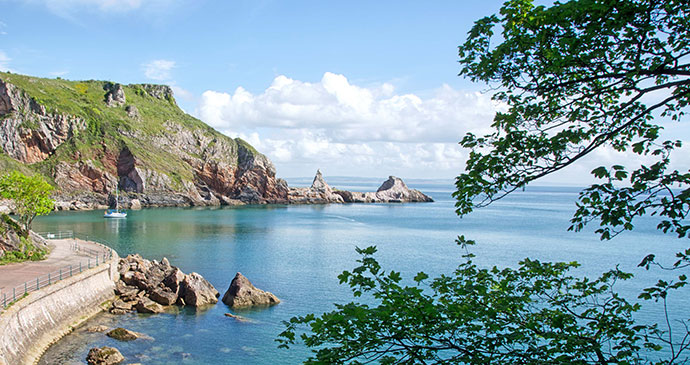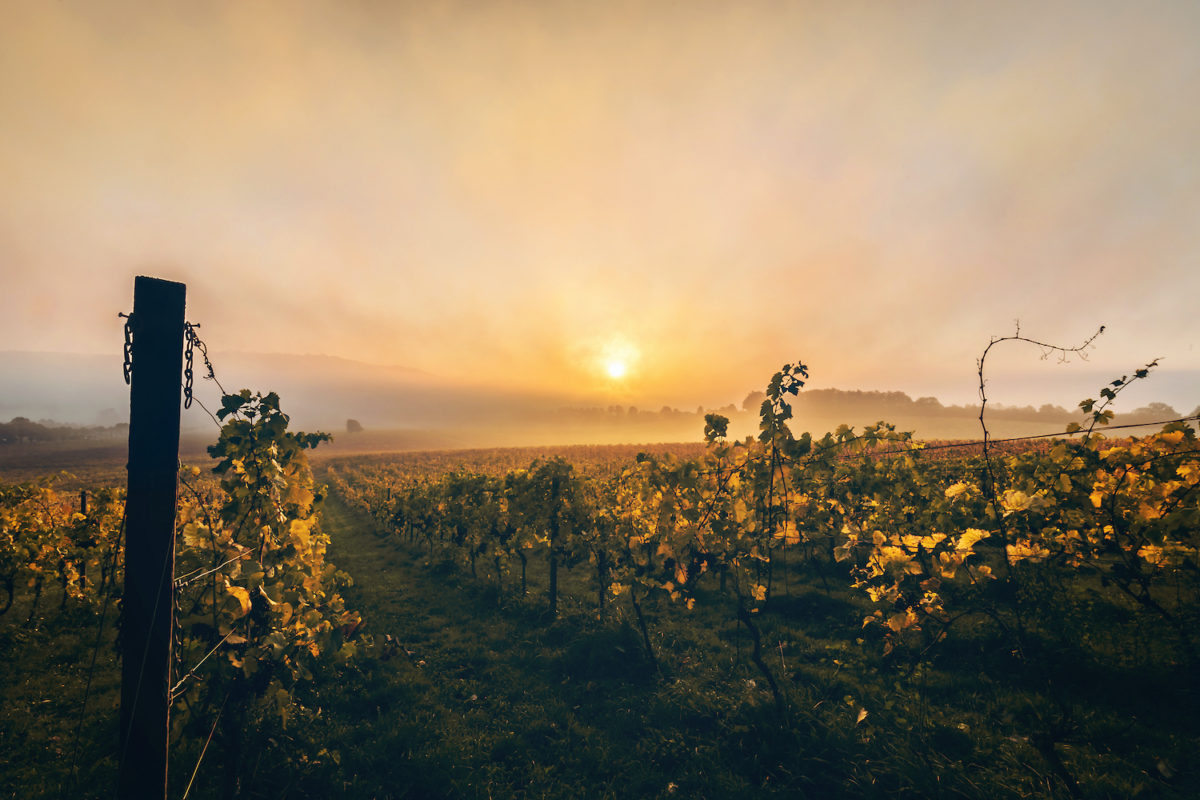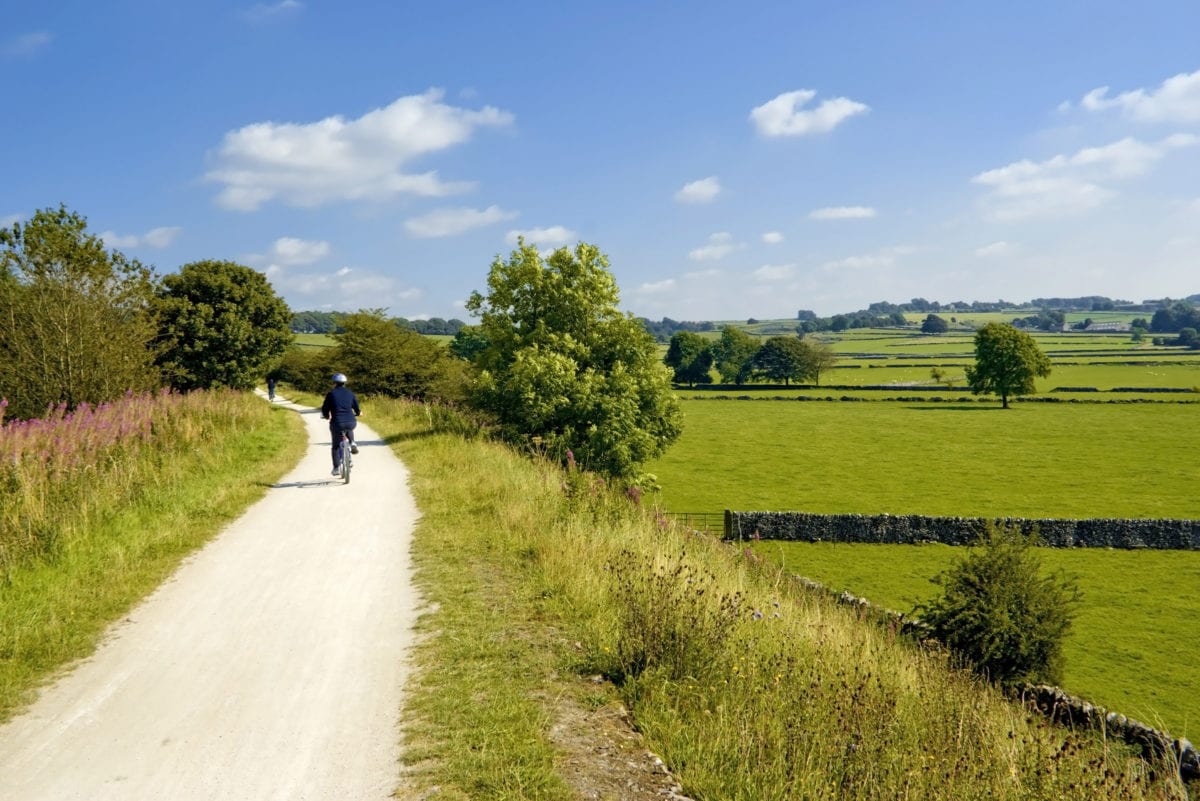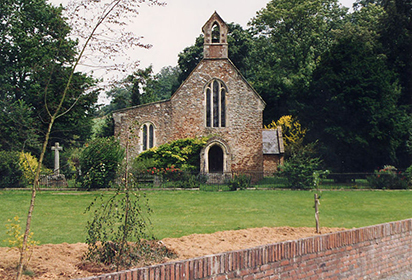Devon’s combination of moor, river and sea is an invitation to travel slowly, whether on foot, bicycle, horseback or in a canoe. The less energetic can watch the scenery gently unfold from the comfort of a steam train or riverboat, or potter around a quintessential English village.
Hilary Bradt and Janice Booth, authors of South Devon and Dartmoor
The moor and the coastal path are just a small part of what makes this county so rewarding for a holiday or short break.
There are chocolate-box-pretty villages with cafés serving cream teas, wild moorland where you may not see another soul for hours, irresistible fishing villages and the splendid River Dart, often described as England’s most beautiful river.
If asked to name the best Devon town, many people would probably say Dartmouth because it and its nearby countryside epitomises all that is best in the county: boats, mansions, sandy coves, woodland. But many would choose elegant Torquay or the quaint Brixham, or perhaps that perennial favourite, the yachting centre of Salcombe. Whatever your interests they can be satisfied here.
Steam trains? There are two such railways in the area. Riding? Pony trekking on Dartmoor is superb and you can even combine it with a pub lunch. Walking? A hundred miles of coastal path is at your feet and an equal number of moorland walks. Wild swimming? We give advice on the very best places. Zoos? Devon’s finest (Paignton) is here, plus some charming smaller places. You don’t have to live here – come and see for yourself.
Bradt on Britain – our Slow Travel approach
Bradt’s coverage of Britain’s regions makes ‘Slow Travel’ its focus. To us, Slow Travel means ditching the tourist ticklists – deciding not to try to see ‘too much’ – and instead taking time to get properly under the skin of a special region. You don’t have to travel at a snail’s pace: you just have to allow yourself to savour the moment, appreciate the local differences that create a sense of place, and celebrate its food, people and traditions.
For more information, check out our guide to South Devon and Dartmoor
Food and drink in South Devon and Dartmoor
Cream teas and cider are the treats most associated with Devon, and indeed they’re a big part of any holiday here. But foodwise there’s so much more.
With Devon’s high rainfall (shh!) and rich and varied grazing, meat is of exceptional quality, and restaurants take pride in sourcing it from named local farms, so that what you’re eating comes directly or indirectly from our fertile soil. Seafood also is superb, as you might expect in the only English county with two separate sea coasts. Restaurants often have their own suppliers, who rush the catch to them straight from their boat. If you’re self-catering look in fishmongers for the ‘catch of the day’.
Local dairies offer more calorific delights. The very best clotted cream, thick, velvety and yellow, comes from Devon and Cornwall, and its taste is quite unlike that of thinner creams. It can vary according to the breed of cow and the preparation (milk is heated very slowly and then cooled, so that the cream rises to the top and can be skimmed off). A recent transatlantic visitor expected her ‘Devon cream tea’ to be a cup of tea with cream in it, so was surprised to receive freshly baked scones spread thickly with clotted cream and jam, accompanied by a generous pot of tea. In Devon, the jam usually goes on top of the cream, in Cornwall underneath. And to sample the cream tea nominated as the best in Devon, you’ll need to visit an unpretentious outdoor eatery in Dartmouth.

The cheeses range from hard and nutty to soft and squashy, and from raspingly strong to gently creamy; you’ll find them on sale locally. They’re enriched with all manner of herbs and flavours; different dairies have their own specialities, some dating back several centuries. For instance, Quicke’s traditional mature cheddar comes from land near Exeter that has been farmed by the same family for over 450 years; and Curworthy Farm near Okehampton uses a 17th-century recipe.
Pasties are another temptation, and both their fillings (a mix of meat and vegetables) and their pastry vary according to the maker. You’ll just have to sample a few to find your favourite! The aroma as they’re taken from the baker’s oven is hard to resist. In Devon, the crimp (closure) traditionally arches over the top; in Cornwall it’s along the edge of the base.
Drinks
The mild climate and south-facing slopes are also conducive to wine-making, with the Sharpham Vineyard leading the way with its wine tastings, vineyard tours, and café. At Old Walls Vineyard near Teignmouth you can ‘rent’ an area of vines and receive the fruits of its harvest once bottled.
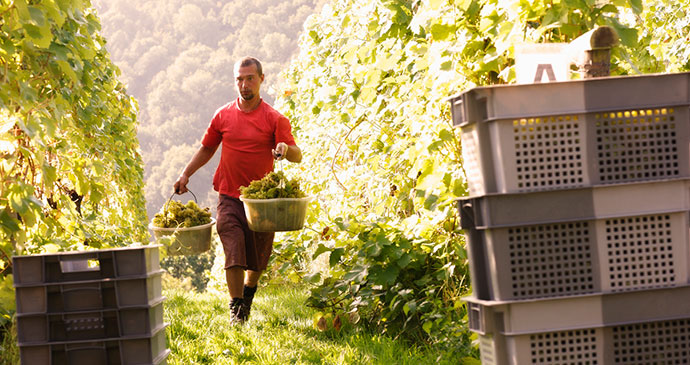
South Devon also has some internationally famous gin distilleries: Salcombe Ginhas won many awards, as has Plymouth Gin, made traditionally by one man in one Victorian copper still. Devon’s first single malt whisky distillery is just getting under way in Bovey Tracey (Dartmoor Whisky Distillery), and planning permission for one in Princetown was granted in 2017. Several breweries around the county, small and larger, have their own ranges of ales: you’ll find them in shops and pubs, together with plentiful local advice as to which you should try.
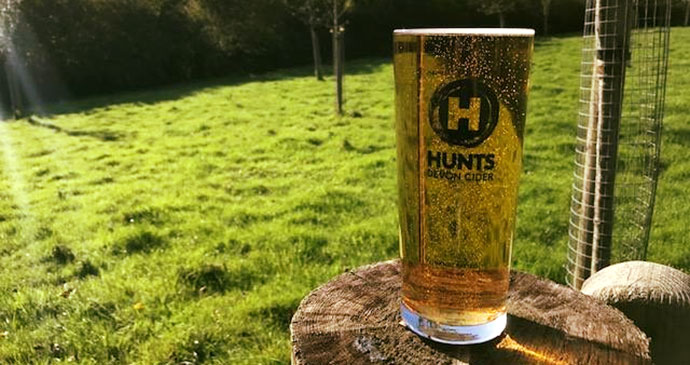
Cider
Two types of cider are brewed in the UK – in eastern counties, Kent and East Anglia, and in the west in Devon and Somerset. We in the West Country have a valid claim that ours is the best. True cider apples are only grown here, and most cider producers use varieties that date back hundreds of years with evocative names such as Fair Maids of Devon, Pig’s Snout, Tail Sweet, Devon Crimson and Slack-Ma-Girdle.
The distinctive cloudy cider, which is unfiltered and unpasteurised, is produced in Devon, as is the famous high-alcohol scrumpy.
Travel in South Devon and Dartmoor
Getting there and around
It goes without saying that Slow Travel favours public transport above the car, and in Devon this isn’t just because it’s better for the environment. Although Devon actually has more miles of road than the whole of Belgium, many of these are car-unfriendly single-track lanes with high banks and hedges where you rely on intuition rather than eyesight to deal with oncoming cars. S P B Mais recognised the problem for drivers: ‘If you keep to the road you will not see Devon at all, only a succession of whitewashed thatched cottages red with fuchsia clustered round a tall grey granite church tower at three- or five-mile intervals as you bore your way through green tunnel after green tunnel.’
It is entirely possible to enjoy a holiday in Devon without a car. Transport to the area is good, and there are usually local buses to get you to the places of interest. A useful organisation for planning journeys by bus and/or train is Traveline.
If you are stuck at a bus stop with no bus and only an unsmart mobile phone, you can phone the number (which is also shown on most bus stops) for help and advice. Another excellent website for all forms of travel – bus, train, cycle, walking – is Travel Devon. Its interactive bus map is particularly useful.
Local buses are a boon for bus-pass holders, but even for paying passengers there are often special deals such as the DevonDay bus ticket which gives unlimited bus travel throughout Devon. Praiseworthy community-run buses such as Tavistock Country Buses are an extra bonus. Devon County Council publishes a series of regional bus timetables as well as a bus map of the county.
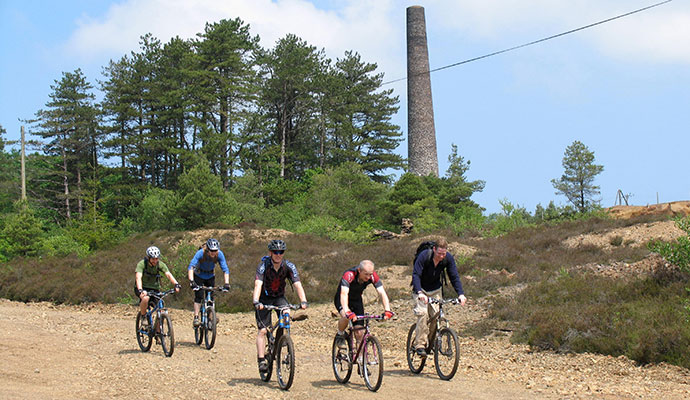
Cycling & walking
This part of Devon has a good range of dedicated cycle paths as well as the 99-mile Coast-to-Coast Route 27 from Ilfracombe to Plymouth. A Croydecycle map covers the whole route. Others are being developed by Sustrans. Among the most popular cycle trails are Drake’s Trail, the Dart Valley Cycle Way, the Granite Way, the Stover Trail, and the Dartmoor Way.
For walkers, there’s the South West Coast Path from Starcross to Plymouth, a distance of almost exactly 100 miles. Some of the best walks in all of Devon are here, with the most rewarding short stretches. Those tackling the whole trail, or planning to walk for several days, would do well to use the services of a luggage transfer company so they can walk unencumbered. Luggage Transfers will also arrange walker-friendly accommodation for you. Likewise, Dartmoor is the starting/finishing point for the Two Moors Way, a stiff but hugely rewarding challenge linking Dartmoor and Exmoor, which can now be extended to Wembury to make coast-to-coast trail.
If you fancy the idea of letting someone else do all the planning and organisation and luggage transfer, the tour operator On Foot Holidays, which specialises in self-guided walking holidays in Europe, has an appealing six-day inn-to-inn walk, A tale of two rivers, taking you from Dunsford on the River Teign to Dartmouth. The longest days are about 20km but these can usually be shortened.
When to visit South Devon and Dartmoor
January
Attend a Wassail
The tradition began a very long time ago, somewhere in the dark aged. A wassail is a ceremony where offerings are made to the apple trees, in the hope their next harvest will be large enough to make plenty of cider. Traditionally held in January, it’s a night filled with singing, dancing and chanting.
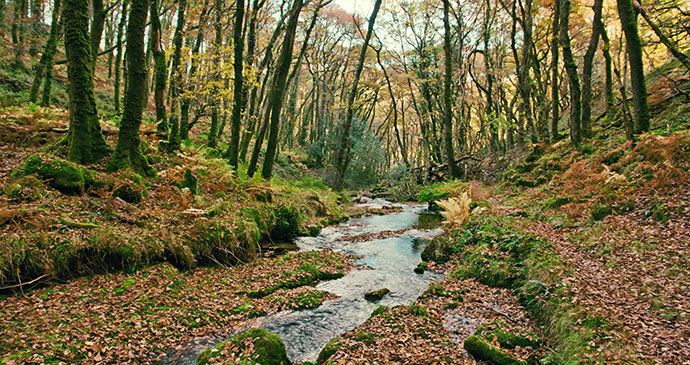
February
Experience the wild beauty of the moors
Being out of traditional season, you can truly experience ‘England’s last wilderness’ and enjoy the feeling of space and silence on the Dartmoor moors.
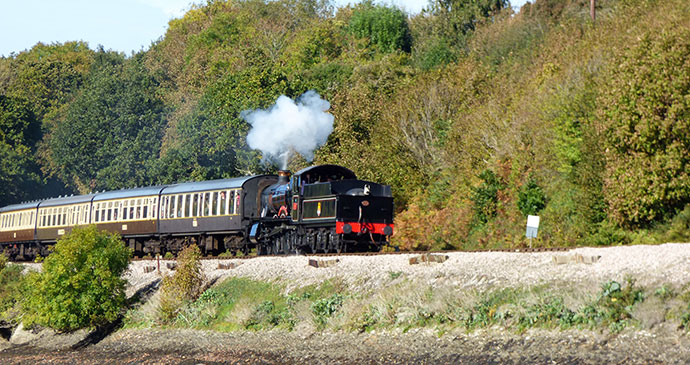
March
Enjoy stunning scenery from the South Devon Steam Railway
Aside from a week in February, the South Devon Steam Railway runs continuously from the middle of March to the end of the year.
April
Attend the Exercise Tiger Annual Memorial Service
An annual memorial service is held at the Sherman tank to commemorate those who lost their lives in Exercise Tiger. Exercise Tiger took place between 26–29 April 1944, as a full rehearsal for Operation Overlord planned for June. During a routine patrol of the English Channel German E-boats discovered the vessels, and fired on two ships, setting fire to one of them with the loss of at least 749 lives.

May
Cycle along one of the region’s trails
Head south from Yelverton in southern Dartmoor and cycle past river valleys and across gorse-bright moorland. It’s particularly stunning in its gorse yellowness and scent.
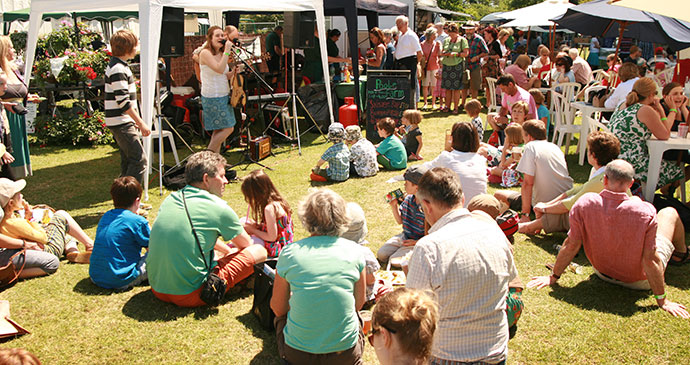
June
Attend the Bovey Tracey Contemporary Craft Festival
Attend the multi-award winning craft festival and see what creations you can find.
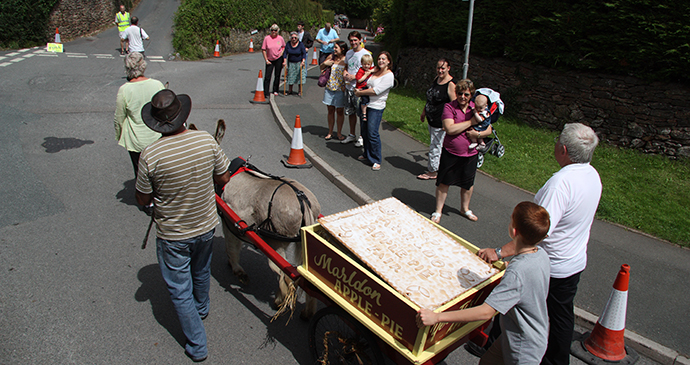
July
Indulge at Marldon’s Apple Pie Fair
This event, held annually in Marldon, has been going since 1888. Locals and visitors alike join in with the celebrations and take part in games and displays.
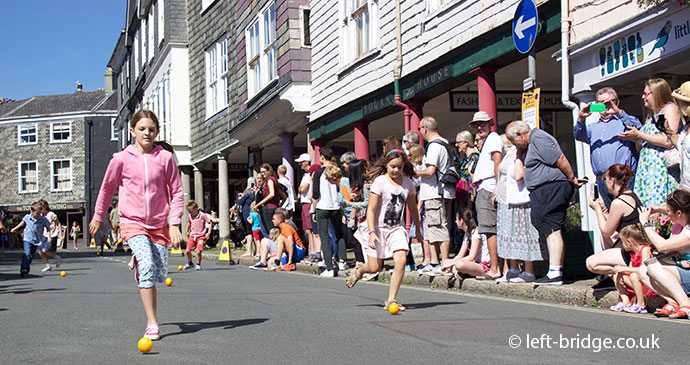
August
Totnes Orange Race
A day like no other, man vs. orange. Locals pursue the fruit down the hill, the speed (and danger) of the pursuit dictated by the age of the contestant; there are races for all age groups, from four to over 60. If you want to see the true definition of breakneck speed, watch the adult men’s group.
September
Eat at the Ashburton Food Festival
This food festival is full of local delights. Not just limited to food, there will be music and comedy shows throughout the day too!
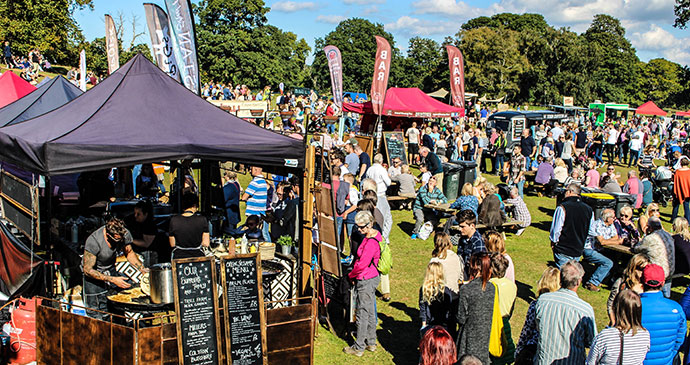
October
Powderham Food Festival
Set in the historic deer park, with Powderham Castle in the background. Indulge in delicious, local food; and choose from a selection of high-quality gifts and crafts.
November
Walk the trails at Lydford
If you enjoy walking this is the place to head to. The trails attract large crowds, so visit in low season, before they close from December to February. The popular Gorge walk is designed as a one-way, circular route, while the most dramatic trail is the Devil’s Cauldron.
December
Visit Dartington Hall
Even when there are no events, Dartington is a wonderfully gentle, peaceful place to visit. One can stroll around the stunning gardens and explore the Great Hall. The gardens are open year-round dawn to dusk, and are free of charge. Make sure to bundle up and appreciate the crisp winter air.
Where to stay in South Devon and Dartmoor
For information about accommodation, see our list of the best places to stay in South Devon and Dartmoor.
What to see and do in South Devon and Dartmoor

The eastern fringe of Dartmoor
The River Teign turns south at Dunsford, and gives map-makers the eastern border of Dartmoor National Park before its final journey to Kingsteignton and Teignmouth. Although technically some of the towns and villages in this section lie within Dartmoor National Park, their gentler, leafier character fits better here. Despite their relative proximity to Exeter and particularly to Newton Abbot, it’s surprising how remote some of them feel.
Along the river are some of the prettiest wooded areas of Dartmoor, splashed by waterfalls, and networked by footpaths and narrow lanes. England’s highest waterfall, Canonteign Falls, is here, as are Stover Park with its inspirational Ted Hughes Poetry Trail and nearby the unique Orchid Paradise in Burnham Nurseries. Then there’s popular Buckfastleigh, whose attractions include the South Devon Steam Railway, Buckfast Abbey, the Valiant Soldier (known as ‘The pub where time was never called’) and the enchanting miniature pigs at Pennywell Farm. The 14th-century stannary town of Ashburton offers intriguing glimpses of its past, while Ipplepen and Torbryan have exceptional churches. And you may more than once catch a passing echo of Conan Doyle’s great detective himself, deerstalker at the ready and John Watson hot on his heels.
Visit the highest church in England at Brentor © Visit Dartmoor – Official Dartmoor Tourism Organisation
The northwestern fringe of Dartmoor
Medieval thatched cottages, centuries-old inns and much-loved little village churches occupy land where prehistoric monoliths, hut circles and burial cairns once stood, and the footprints of early people stretch back a long, long way. Sheep and red Devon cattle graze in the fields, and crops ripen through deepening shades of green to dusty gold. Between gaps in the trees, the hills and tors of Dartmoor appear as a distant backdrop.
Parts lie away from the tourist routes, allowing the occasional hamlet to be unselfconsciously unadorned. In one tourist information centre the assistant told me: ‘The cottages down there are lovely because they haven’t been titillated,’ leaving me to wonder what a titillated cottage might get up to. Others are in their full thatched and whitewashed finery, with competitive gardens and cats dozing on windowsills.
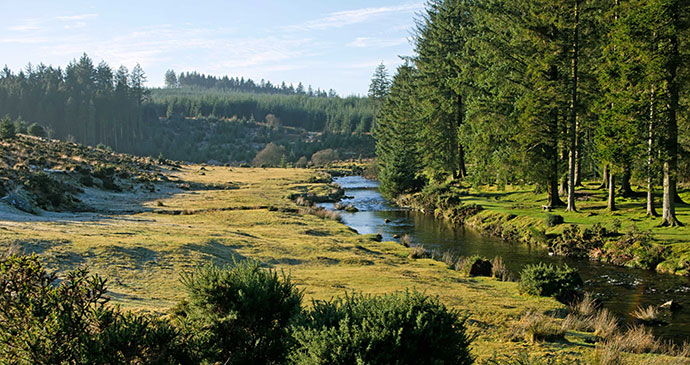
Dartmoor National Park
Look at any map of Devon and you’ll see the largely roadless blob that is Dartmoor. Literature and imagination give it an air of menace: The Hound of the Baskervilles, a bleak prison where the surrounding moor is the best security, and craggy tors emerging from heavy, disorientating mists. This national park is high – the highest land in England south of the Pennines – leaving the visitor exposed to raw winds sweeping in from the Atlantic. But there’s a softer side to Dartmoor: sheltered, wooded valleys which feel a world away from the typical moor. So if you want Dartmoor bleakness you can find it. Once you cross a cattle grid the hedges disappear, sheep and ponies raise their heads to watch you pass, and the wind catches your hair as you reach for a sweater. You can walk for hours without seeing a road – or a tree. And everywhere you see granite: rocks as large as cars scattered randomly or piled on top of hills to form the tors that define Dartmoor, quarried and dressed in the walls of the ancient village churches, or rough-hewn and arranged in circles or rows by the first humans to make the moor their home.
The low-lying perimeter is another world, however, networked by deep narrow lanes. Footpaths meander through gentle, flower-filled meadows or dark woodland, or along the banks of rivers. The Tavy, Teign and Dart dominate, but all have tributaries and you are never far from a brook. Hidden in the valleys are small villages, their church towers poking through the trees, and welcoming pubs. But no one visiting here would stay only in the valleys; Dartmoor is the high moor. You may regret venturing up there in mist and rain, but on a sunny day its wildness is alluring. It’s aptly called England’s last wilderness, and the feeling of space and silence, broken only by the trilling of skylarks and the scrunching of boots on stones, is intoxicating.
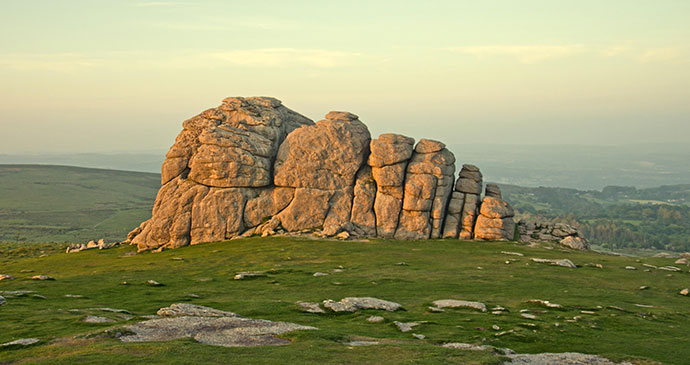
Dartmoor also has, uniquely, its visible prehistory in the monuments such as hut circles and stone rows that litter the moor. A newcomer might assume the tors are also the work of prehistoric people. The word comes from the Celtic twr, or tower, but these are the work of nature – erosion – not of man. And in an area that has blessedly few ‘tourist attractions’ nature has provided children with some rewarding scrambles and adults with hills to test their stamina, as well as giving Dartmoor its unmistakable horizon.
For information about Dartmoor, see www.visitdartmoor.co.uk.
The tiny bay of Anstey’s Cove is an unexpected delight © Unique Devon Tours
The English Riviera: Torbay
The wide, curved deepwater harbour of Tor Bay has played a regular part in history, as well as attracting more recent visitors to its mild climate and sandy beaches. W G Maton, writing in 1794, reported: ‘The bay appears to be about twelve miles in compass [four miles as the gull flies], and is reckoned one of the finest … for ships our coast can boast of.’ The Napoleonic Wars (1799–1815) elevated the area still further, partly because the Channel Fleet was anchored in Tor Bay for a while, with Napoleon aboard en route to exile on St Helena, and partly because the war in Europe prevented the nobility from doing the Grand Tour abroad so some used the Devon coast as a substitute. Indeed, Napoleon may have inadvertently promoted the area as a holiday destination. On seeing the bay for the first time he is said to have exclaimed: ‘Enfin, voilà un beau pays!’ Suddenly, Torquay was fashionable and once the Great and the Good started coming here, they never really stopped.
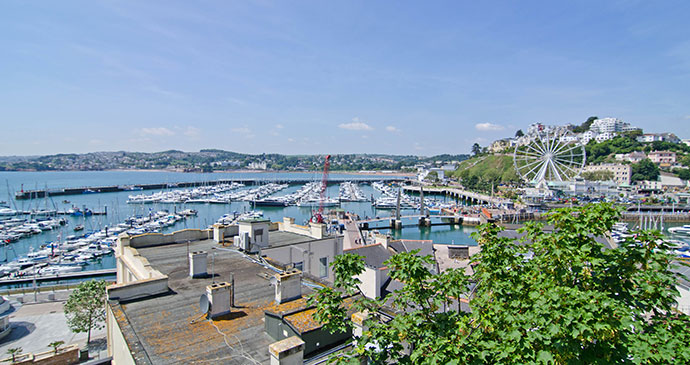
The bay area with its linked towns is officially known as Torbay, but the marketing people prefer ‘The English Riviera’. Torquay has its downside – big department stores and traffic jams – and Slow visitors may find Paignton hard to love, but if you know where to go and what to see there are all sorts of pleasures to be found: excellent art exhibitions, the spookily fascinating Kents Cavern (Torbay is one of UNESCO’s Geoparks – the term given to areas of exceptional geological interest), and surprisingly rural lanes folded into the hills behind the town. Tucked behind the craggy projections of Berry Point and Hope’s Nose which contain the bay are quiet beaches and small, pebble-and-sand coves, with more secluded beaches further north towards Teignmouth.
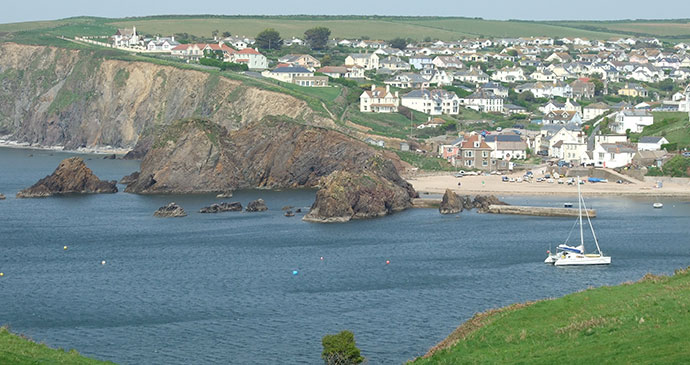
The South Hams and Devon’s far south
The extreme south of Devon has its roots planted firmly in the sea; the coast and all it can offer is the magnet for visitors here, with Salcombe its epicentre. From here you can hire a boat and putter around the estuary, select some of the most scenic stretches of the South West Coast Path, or spend the day on one of the sandy beaches. This is an enduringly favourite family destination.
Coming from Dartmouth in the east, the first place of special interest is Slapton, with its long beach that stood in for Normandy in practices for the D-Day landings. But hereafter visitors gravitate south, below the A379. Here, in the South Hams, Devon points two knuckles towards Brittany, bifurcated by the estuary up which a weekly steamer used to carry merchandise to and from Kingsbridge. The name South Hams probably derived from the Saxon hamm, which meant peninsula but also a homestead or village. Some take it literally, and there are plenty of piggy references in the coastal landscape here: Pig’s Nose, Ham Stone, Gammon Head.
Among a clutch of likeable and highly photogenic villages on the west coast are Thurlestone and the enchantingly named Inner and Outer Hope. Cross the River Avon, with its trick pronunciation to reach Bigbury-on-Sea and walk or take the sea tractor at high tide to Burgh Island. The sea isn’t the only attraction in the region, however. If you’re heading south from Dartmoor and the A38, you’ll pass through Loddiswell, little known but with plenty to see and do.
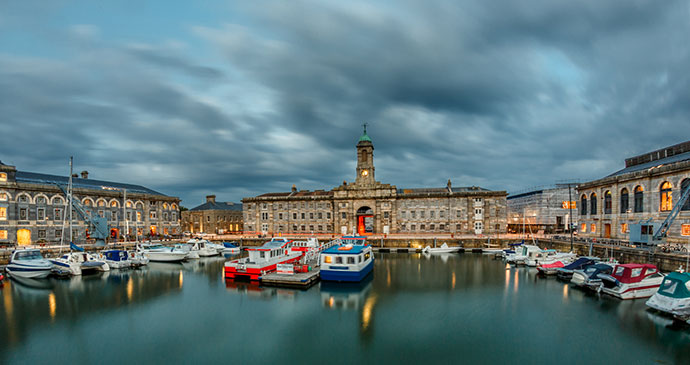
Plymouth and the Tamar Valley
More than 400 years before the Duke’s appreciation of Plymouth, one of the ‘spacious channels’ he mentions, the River Tamar, was carrying tin, lead and silver ores seaward from the mines on and around Dartmoor. Then copper was discovered and, by the 19th century, the Tamar valley was Europe’s largest source of copper ore and Morwellham Quay was briefly England’s busiest port. Today Morwellham has dwindled into historic tranquillity, whereas Plymouth has ‘increased in buildings and population’ so much that the Elizabethan seafarers who once knew every nook and cranny would have a hard time finding their way around.
Some of the leafiest lanes and prettiest moorland of Dartmoor National Park lie only a few miles from Plymouth. Dartmoor Zoo is here, the artistic delights of Delamore House, and the gateway villages of Yelverton and Ivybridge, along with one of the region’s best hotels. The coastline also has some beautiful bays and beaches.
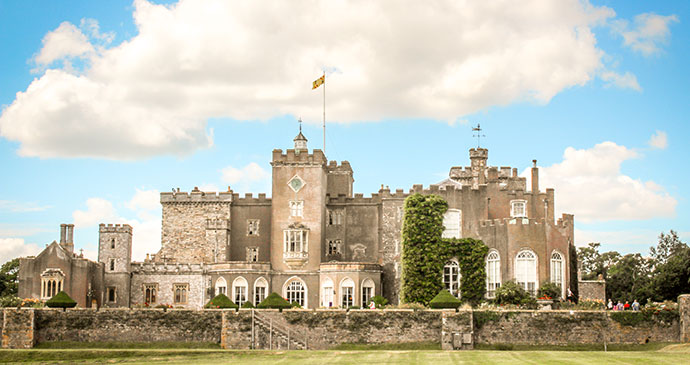
The Exe & Teign Estuaries
This area may not often hit the touristic headlines but it has some of South Devon’s loveliest views and best birdwatching. Flatter than much of the county, it is friendly to walkers and cyclists, and its lack of main roads and large ‘attractions’ makes it well and truly Slow. Into a smallish space it packs rivers, thatched cottages, small ancient churches, beaches, cliffs and coastal views; while local museums and heritage centres offer glimpses of a fascinating rural past. The Exe and Teign estuaries host an exceptional variety of birdlife, and the rail journey southward from Exeter includes one of Britain’s most scenic stretches.
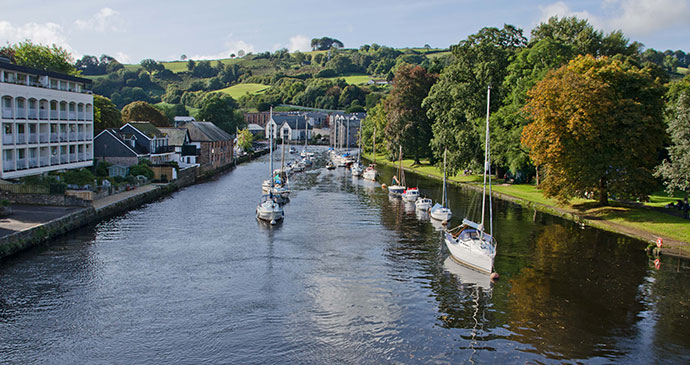
Totnes and the River Dart
The Dart is one of the loveliest rivers in England and, like Devon’s three other great rivers, the Exe, the Plym and the Taw, has played an important part in shaping the county’s history. It rises in Dartmoor and meanders down to Dartmouth for 42 miles, with the lower 11 miles tidal. Totnes, at the upper navigable end, has been a prosperous town since at least the 10th century, and continues the trend thanks to the energy and creativity of its inhabitants. Of all the larger towns in Devon, this is perhaps the most rewarding to visit, so provides a perfect starting or finishing point for a walk or cruise down/up the Dart. Although Totnes is as far inland as you can go by passenger boat, the Dart is still a significant presence north of the town, and Dartington Hall, with its focus on sustainability and the arts, perfectly complements the spirit of Totnes. The South Devon Railway follows the river upstream as far as Buckfastleigh.
As the river snakes its way south, it passes small villages or grand houses which flourished as a result of their location and then subsided into tranquillity when water transport ceased to be viable. Now they are an ideal base for exploring this exceptionally scenic part of Devon, and for refreshment while walking the Dart Valley Trail. At the river mouth is Dartmouth, and its twin town Kingswear, which have been enchanting travellers for centuries, and to the east and west stretches the South West Coast Path.
Related books
For more information, see our guide to South Devon and Dartmoor:
Related articles
These are some of the more unlikely locations for vineyards in England… hicc!
Leave the car behind and explore Britain’s highways, byways and coastal pathways on two wheels.
Our founder Hilary Bradt and Janice Booth, authors of Slow Travel: South Devon and Dartmoor, discuss their favourite churches from the region.
